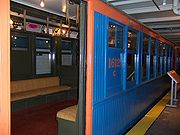
Q-type Queens car (New York City Subway car)
Encyclopedia

New York City Subway
The New York City Subway is a rapid transit system owned by the City of New York and leased to the New York City Transit Authority, a subsidiary agency of the Metropolitan Transportation Authority and also known as MTA New York City Transit...
car rebuilt in 1938 by the Brooklyn–Manhattan Transit Corporation (BMT) for elevated railway
Elevated railway
An elevated railway is a form of rapid transit railway with the tracks built above street level on some form of viaduct or other steel or concrete structure. The railway concerned may be constructed according to the standard gauge, narrow gauge, light rail, monorail or suspension railway system...
service to the 1939 New York World's Fair
1939 New York World's Fair
The 1939–40 New York World's Fair, which covered the of Flushing Meadows-Corona Park , was the second largest American world's fair of all time, exceeded only by St. Louis's Louisiana Purchase Exposition of 1904. Many countries around the world participated in it, and over 44 million people...
from BU cars
BU cars (New York City Subway car)
BU cars is the generic term for BRT elevated gate cars used on predecessor lines of the New York City Subway system.-Background:These cars consisted of a variety of equipment used on the BRT and later BMT. Some cars were inherited from steam railroads that became part of the BRT system while others...
in the 1200 and 1400 series, elevated stock originally built in 1903 and 1907.
After BMT service on the joint IRT
Interborough Rapid Transit Company
The Interborough Rapid Transit Company was the private operator of the original underground New York City Subway line that opened in 1904, as well as earlier elevated railways and additional rapid transit lines in New York City. The IRT was purchased by the City in June 1940...
-BMT Flushing Line
IRT Flushing Line
The Flushing Line is a rapid transit route of the New York City Subway system, operated as part of the IRT Division and designated the 7 route...
ended in 1949, the Q-types were refitted for operation of the IRT Third Avenue Line
IRT Third Avenue Line
The IRT Third Avenue Line, commonly known as the Third Avenue El, was an elevated railway in Manhattan and the Bronx, New York City. Originally operated by an independent railway company, it was acquired by the Interborough Rapid Transit Company and eventually became part of the New York subway...
in Manhattan
Manhattan
Manhattan is the oldest and the most densely populated of the five boroughs of New York City. Located primarily on the island of Manhattan at the mouth of the Hudson River, the boundaries of the borough are identical to those of New York County, an original county of the state of New York...
. After the latter line closed in 1955, the Q-types were refitted again to operate on the BMT Myrtle Avenue Line
BMT Myrtle Avenue Line
The Myrtle Avenue Line, also called the Myrtle Avenue Elevated, is a fully elevated line of the New York City Subway as part of the BMT division. The extant line is the final remnant of one of the original Brooklyn elevated railroads...
in 1958 to replace the last elevated gate cars in passenger service. When the lower part of the Myrtle Avenue Line closed in 1969, the Q-types were finally retired. The oldest of the cars were in revenue service for 66 years, currently the longest such service life in New York City
New York City
New York is the most populous city in the United States and the center of the New York Metropolitan Area, one of the most populous metropolitan areas in the world. New York exerts a significant impact upon global commerce, finance, media, art, fashion, research, technology, education, and...
rapid transit
Rapid transit
A rapid transit, underground, subway, elevated railway, metro or metropolitan railway system is an electric passenger railway in an urban area with a high capacity and frequency, and grade separation from other traffic. Rapid transit systems are typically located either in underground tunnels or on...
operations. Car 1612C is at the New York Transit Museum. It is never used for trips since it is a one of a kind car today, and may not be compatible with the BU cars in the museum now. The only other surviving Q-type is 1602C, which is at the Trolley Museum of New York., awaiting restoration, coupled with that museum's other subway car units.
Q-type Specifications
- Car Builder: Jewett Car CompanyJewett Car CompanyThe Jewett Car Company was an early 20th century American industrial company that manufactured street cars.The company was founded in 1893 in Jewett, Ohio, where its first factory was located. In 1904, the company relocated from Jewett to a site along South Williams Street in Newark, Ohio, but...
, Newark, OhioNewark, OhioIn addition, the remains of a road leading south from the Octagon have been documented and explored. It was first surveyed in the 19th century, when its walls were more apparent. Called the Great Hopewell Road, it may extend to the Hopewell complex at Chillicothe, Ohio...
- Re-built by: Brooklyn–Manhattan Transit Corporation
- Car Body: Wood with steel ends
- Unit Numbers: 1600-1629 A-B-C (Q) and 1630-1641 A-B (QX)
- Fleet: 114 cars assembled into 42 operating units
- Car Length: 49 feet, 3 inches
- Car Width: 8 feet, 8 inches
- Car Height: 12 feet (3.7 m)
- Track Gauge: standard
- Propulsion System: WH 225113 (Q)/ WH 225112 (QX)
- Motors(1 per motor truck on Q, 2 per motor truck on QX): GE 259, WH 336 (Q)/ WH 300 (QX)
- Power: 120 hp per motor (Q)/ 200 hp per motor (QX)
- Total Seating: 50 seats (A and C cars), 52 seats (B car)(Q)/ 50 seats (A and B cars)(QX)
- Total Weight: 57000 lb (25,854.8 kg)

